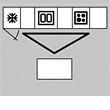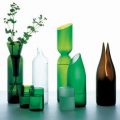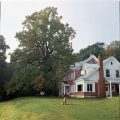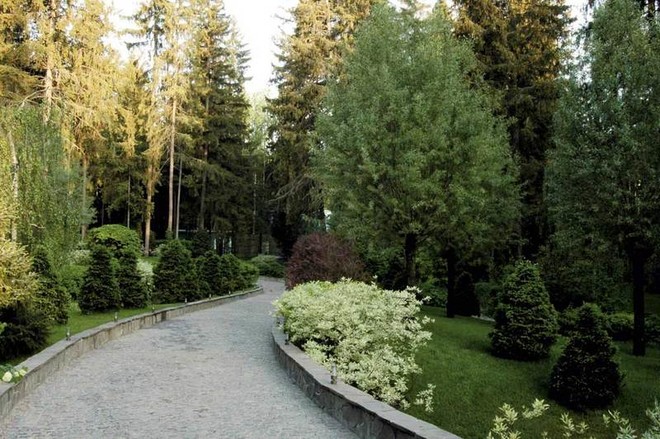 Classic garden
Classic garden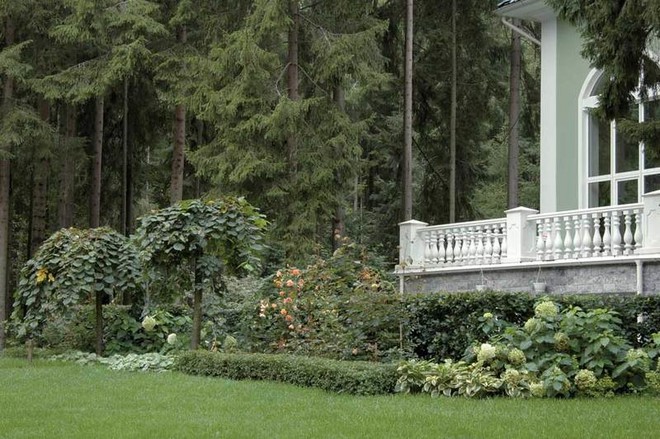 Garden in Russian style
Garden in Russian style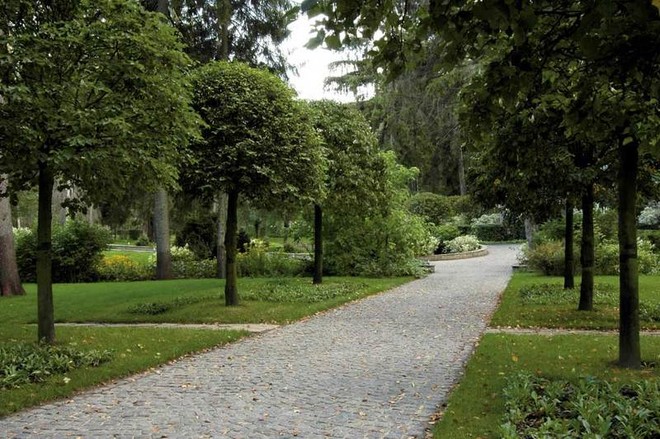 An alley of linden trees in the shape of a “ball on a standard”.Everything flows, everything changes, and something needs to be done about itThe main decoration of this park, spread over one and a half hectares of old spruce forest, is the river. You don’t have to be a landscape specialist to know that even the smallest river improves the microclimate of the park, increases the comfort of recreation areas and adds romance to them. But you do have to be a specialist to know that the river can become the main problem in the work. “Before we cleared and deepened its bed, gave it clearer outlines and strengthened the banks, during floods the river overflowed the entire site, from fence to fence,” recalls Alexander Grivko, art director of Il Nature. “The flooding was facilitated by the close standing of groundwater. Let me make a reservation right away: the work to strengthen and clear the banks was carried out very carefully.” so as not to change the water balance of the site, not to disturb the coastline, the natural speed of the water flow and the natural ecosystem of the reservoir as a whole. And by the river, by the river... Moisture-loving plants are planted along the banks - irises, hosta, loosestrife, dogwood, willows. For them, the wetter the better (under normal conditions, willows have to make a special clay "zam" to retain moisture). Naturally, no one tried to plant roses, maples or lindens by the river. They are afraid of spring floods and especially cold melt water - lindens should be planted in places where there is no stagnant water.
An alley of linden trees in the shape of a “ball on a standard”.Everything flows, everything changes, and something needs to be done about itThe main decoration of this park, spread over one and a half hectares of old spruce forest, is the river. You don’t have to be a landscape specialist to know that even the smallest river improves the microclimate of the park, increases the comfort of recreation areas and adds romance to them. But you do have to be a specialist to know that the river can become the main problem in the work. “Before we cleared and deepened its bed, gave it clearer outlines and strengthened the banks, during floods the river overflowed the entire site, from fence to fence,” recalls Alexander Grivko, art director of Il Nature. “The flooding was facilitated by the close standing of groundwater. Let me make a reservation right away: the work to strengthen and clear the banks was carried out very carefully.” so as not to change the water balance of the site, not to disturb the coastline, the natural speed of the water flow and the natural ecosystem of the reservoir as a whole. And by the river, by the river... Moisture-loving plants are planted along the banks - irises, hosta, loosestrife, dogwood, willows. For them, the wetter the better (under normal conditions, willows have to make a special clay "zam" to retain moisture). Naturally, no one tried to plant roses, maples or lindens by the river. They are afraid of spring floods and especially cold melt water - lindens should be planted in places where there is no stagnant water.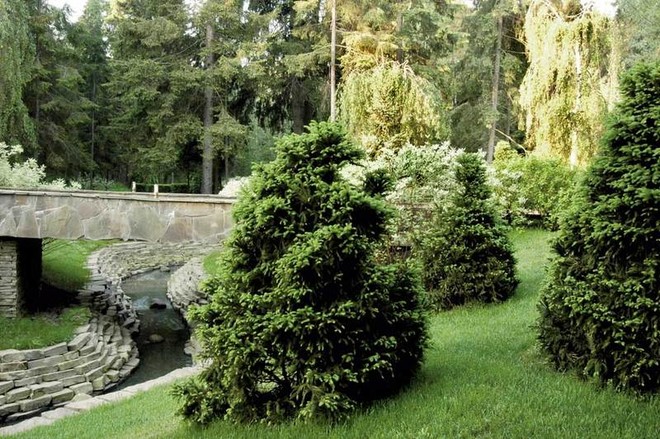 On the banks of the river planted moisture-loving plants.
On the banks of the river planted moisture-loving plants.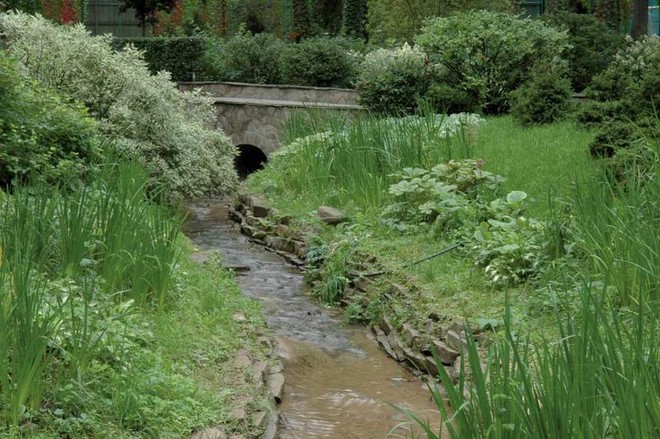 On the shore there are moisture-loving irises, loosestrife, hosta, white dogwood, and ligularia. Along the path leading to the bridge there are spherical euonymus.
On the shore there are moisture-loving irises, loosestrife, hosta, white dogwood, and ligularia. Along the path leading to the bridge there are spherical euonymus.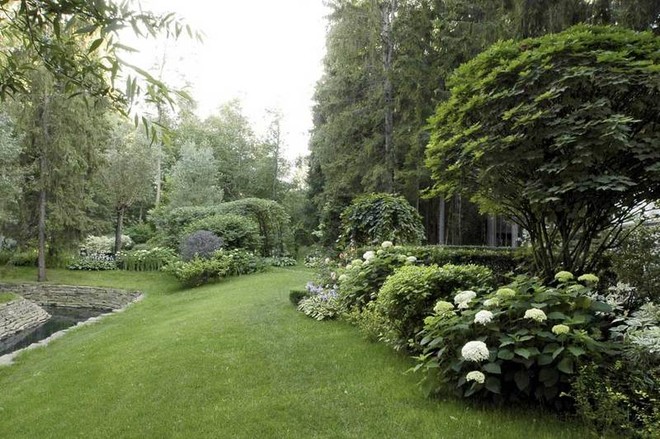 The bank slopes were strengthened with the help ofgeogrids and rolled lawn. All attention is on nature! The customers wanted the park (and this is a park, not a garden, since its area is more than one hectare and it has all the park elements: alleys, pavements, squares, walking paths) - so, the customers wanted the park to look as natural as possible. Therefore, we did not introduce complex forms and multi-level parterres (typical for French regular parks), there are no sculptures and fountains. And even the lighting is thought out in such a way that the lanterns do not attract unnecessary attention. We preserved areas of virgin forest behind the house, only slightly tidied it up: removed the weedy undergrowth, treated the trees, laid paths, planted groups of flowering shrubs, arranged mixborders, and installed electricity. But nevertheless, the overall impression that you are in a forest remains. Another distinctive feature of this park is the absence of motley colors. It is built on different shades of green, although there are flowers here, of course. How could it be without them?
The bank slopes were strengthened with the help ofgeogrids and rolled lawn. All attention is on nature! The customers wanted the park (and this is a park, not a garden, since its area is more than one hectare and it has all the park elements: alleys, pavements, squares, walking paths) - so, the customers wanted the park to look as natural as possible. Therefore, we did not introduce complex forms and multi-level parterres (typical for French regular parks), there are no sculptures and fountains. And even the lighting is thought out in such a way that the lanterns do not attract unnecessary attention. We preserved areas of virgin forest behind the house, only slightly tidied it up: removed the weedy undergrowth, treated the trees, laid paths, planted groups of flowering shrubs, arranged mixborders, and installed electricity. But nevertheless, the overall impression that you are in a forest remains. Another distinctive feature of this park is the absence of motley colors. It is built on different shades of green, although there are flowers here, of course. How could it be without them?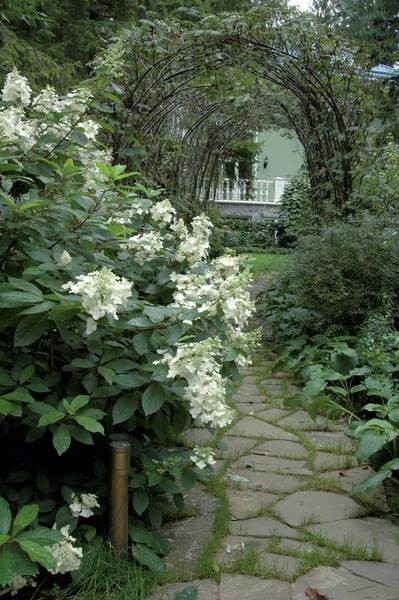
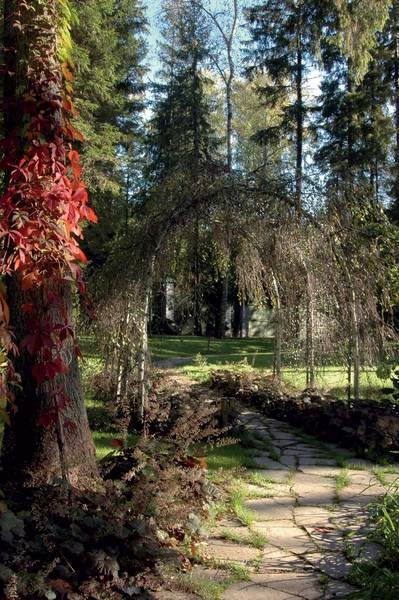
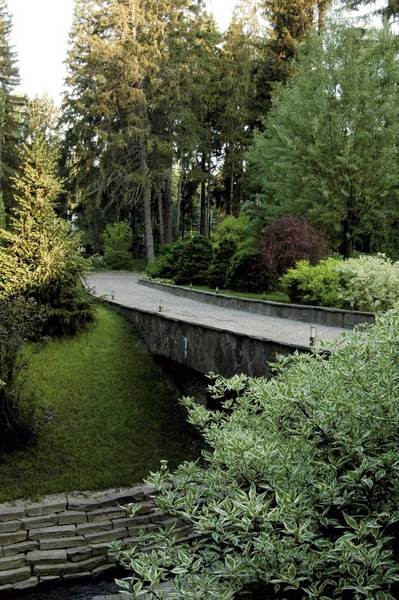
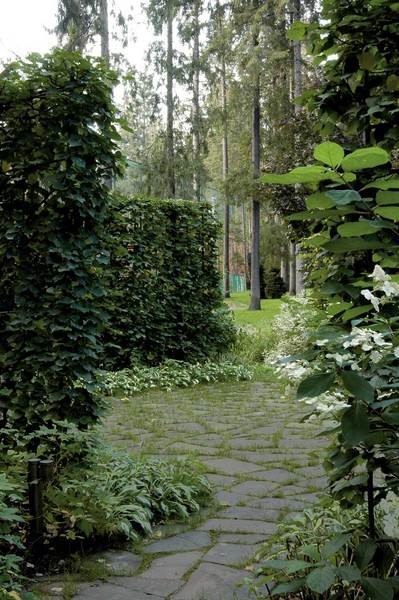
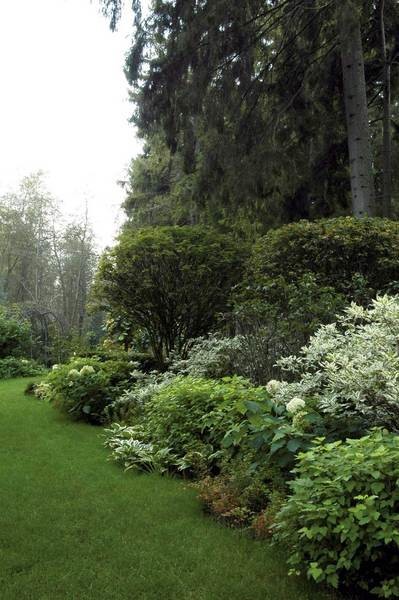
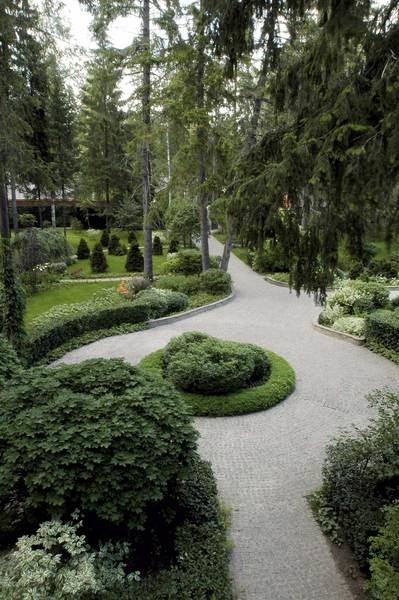 Photo №1 High lights are installed onlyin the forest part of the park. Hydrangea paniculata is illuminated by low lantern posts. Photo #2 Birch arches - a Russian alternative to the French rose berceaux. Photo #3 The main road to the house is paved with silver-gray granite paving stones. Photo #4 Tall lanterns are installed only in the forest part of the park. Hydrangea paniculata is illuminated by low lantern posts. Photo #5 A parterre row of barberry, hosta, viburnum-leaved bladder-senna and Norway maples is planted in front of the forest part of the site. Photo #6 View from the second floor windows. It is Russian. That explains a lot - the park design is based on the tradition of old Russian estates, says Alexander. — Today, this is one of the main trends in Russian landscape gardening. More and more of our customers are drawn to Russian traditions and moving away from European trends. We have tried, as much as possible, to revive the authentic look of a Russian estate. Let's be honest: traditional landscape gardening (as an art) has been lost in Russia. I don't mean Peterhof (it's 100% Europe). We are talking about the Russian tradition, the founder of which is considered to be the brilliant scientist and plant breeder Andrey Timofeevich Bolotov (if you have time, be sure to visit his museum-estate "Dvoryaninovo" in the Tula region - you won't regret it). Historically, Russian parks included elements of all European parks with the replacement of heat-loving overseas plants with local ones (many varieties were bred by A. T. Bolotov in the 18th century). This project uses elements traditional for Russian parks - for example, rowan and birch arches (analogous to the French rose berceaux), linden trellises, hawthorn hedges, "balls" of Norway maples (from the second-floor window they look like large green beads scattered around the site), unusual weeping elms on high trunks (they form the wings in front of the entrance to the tea-drinking area). The existing spruce forest is echoed by the compact-shaped selection of fir trees that we planted near the house (they reach four meters in width and will stretch to a maximum of two meters in height). Euonymus, familiar to everyone, shapeless bushes, appear here as neat balls. The real pearl of this park is the Norway willow with a crown in the form of an open fan. Local plant species not only help to organically fit the park into the surrounding nature, but also make it unpretentious (these are roses, the trees are pruned a maximum of twice a season).
Photo №1 High lights are installed onlyin the forest part of the park. Hydrangea paniculata is illuminated by low lantern posts. Photo #2 Birch arches - a Russian alternative to the French rose berceaux. Photo #3 The main road to the house is paved with silver-gray granite paving stones. Photo #4 Tall lanterns are installed only in the forest part of the park. Hydrangea paniculata is illuminated by low lantern posts. Photo #5 A parterre row of barberry, hosta, viburnum-leaved bladder-senna and Norway maples is planted in front of the forest part of the site. Photo #6 View from the second floor windows. It is Russian. That explains a lot - the park design is based on the tradition of old Russian estates, says Alexander. — Today, this is one of the main trends in Russian landscape gardening. More and more of our customers are drawn to Russian traditions and moving away from European trends. We have tried, as much as possible, to revive the authentic look of a Russian estate. Let's be honest: traditional landscape gardening (as an art) has been lost in Russia. I don't mean Peterhof (it's 100% Europe). We are talking about the Russian tradition, the founder of which is considered to be the brilliant scientist and plant breeder Andrey Timofeevich Bolotov (if you have time, be sure to visit his museum-estate "Dvoryaninovo" in the Tula region - you won't regret it). Historically, Russian parks included elements of all European parks with the replacement of heat-loving overseas plants with local ones (many varieties were bred by A. T. Bolotov in the 18th century). This project uses elements traditional for Russian parks - for example, rowan and birch arches (analogous to the French rose berceaux), linden trellises, hawthorn hedges, "balls" of Norway maples (from the second-floor window they look like large green beads scattered around the site), unusual weeping elms on high trunks (they form the wings in front of the entrance to the tea-drinking area). The existing spruce forest is echoed by the compact-shaped selection of fir trees that we planted near the house (they reach four meters in width and will stretch to a maximum of two meters in height). Euonymus, familiar to everyone, shapeless bushes, appear here as neat balls. The real pearl of this park is the Norway willow with a crown in the form of an open fan. Local plant species not only help to organically fit the park into the surrounding nature, but also make it unpretentious (these are roses, the trees are pruned a maximum of twice a season).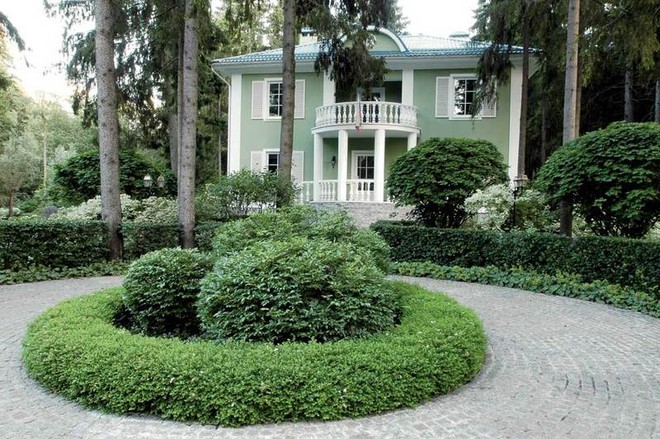 The central square in front of the house is framed by a hedge of hawthorn. Spheriform growth sprouts grow in a ring of Japanese spiraea.
The central square in front of the house is framed by a hedge of hawthorn. Spheriform growth sprouts grow in a ring of Japanese spiraea.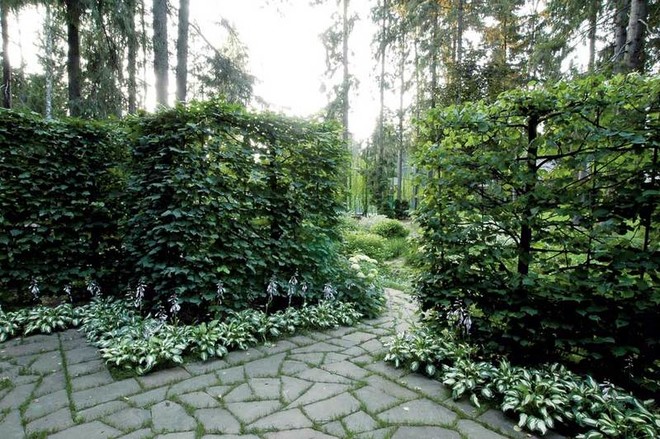 The floor of the "green living room" is paved with a crushed sandstone with a grassy seam. For this, the cracks between the stones were covered with earth with an admixture of seeds of shade-loving lawn grasses.
The floor of the "green living room" is paved with a crushed sandstone with a grassy seam. For this, the cracks between the stones were covered with earth with an admixture of seeds of shade-loving lawn grasses.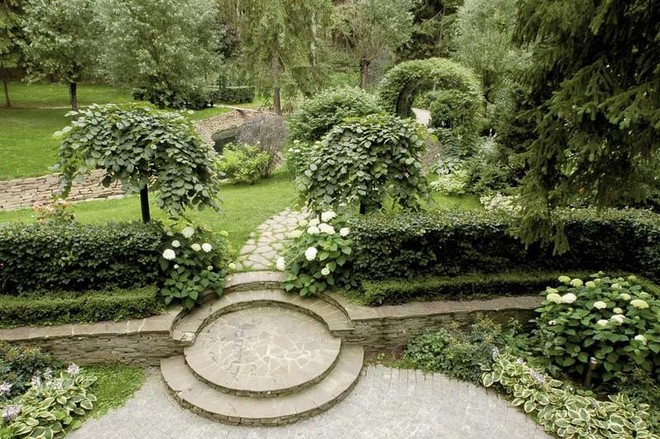 The entrance to the tea area is flanked by a coupleweeping elms. The retaining walls are made of sandstone. In the best traditions of "This park is Russian, built on the traditions of Russian landscape gardening," the authors of the project proudly say. It is interesting that A. T. Bolotov also set similar goals. In the 18th century, he wrote: "It would not be a little shameful for us if we had gardens that were neither English nor French, but our own and invented by us, and when they began to be called Russian!" The design and implementation of the park was carried out by Il Nature, art director Alexander Grivko, tel. 797 4740. Sketch of the general plan of the site The total area of the site is 1.5 hectares.
The entrance to the tea area is flanked by a coupleweeping elms. The retaining walls are made of sandstone. In the best traditions of "This park is Russian, built on the traditions of Russian landscape gardening," the authors of the project proudly say. It is interesting that A. T. Bolotov also set similar goals. In the 18th century, he wrote: "It would not be a little shameful for us if we had gardens that were neither English nor French, but our own and invented by us, and when they began to be called Russian!" The design and implementation of the park was carried out by Il Nature, art director Alexander Grivko, tel. 797 4740. Sketch of the general plan of the site The total area of the site is 1.5 hectares.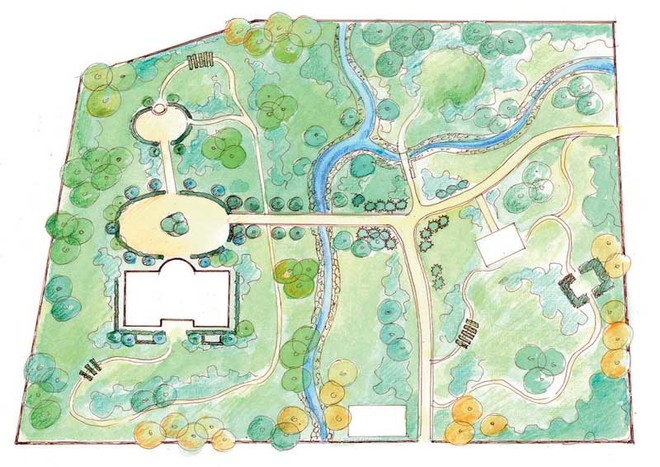

Making Money with Desserts: Success Stories
Evgeniya Polischuk (Fedutinova) instagram:@evgeniyafedutinovavk.com/janeshomebaking– It all started with baking for family and friends. Gradually, I started posting photos of my baked goods on Instagram – and orders started coming in. I made my first custom-made cake on October 13, 2014, and a little earlier I started making macaroons and cupcakes. You could say that the business “found me”, I am very […]

Soups are cold recipes with photos
Cold cucumber soup with yogurt and lemonsorbet from the chef of the restaurant La Taverna Alexander Zhurkin Photo: Getty Images Ingredients: Plain yoghurt – 125 g Cucumber – 150 g Lemon/lime sorbet – 50 g Cocktail shrimp – 24 g Fresh ginger juice – 1 g Lime juice – 5 g Fresh orange juice – 5 g Parsley – 1 g Pink pepper – 1 g Watercress – […]

barbeque kebab
Pork tenderloin in glaze Photo:Dmitry Bayrak/dbstudioPreparation time: 20 minutes + marinating time.Calories: 454 kcal per serving.For 4 servings: 4 pork tenderloins (approximately 300 g each), 1 onion, 2 cloves of garlic, 1 tsp. lemon zest, 1 tsp. lemon juice, a pinch of ground cumin, coriander and turmeric, 1 tbsp. vegetable […]

Pierre Duacan: dietary recipes: Ducane diet
Beetroot soup Photo:Season’S, Luxury Hotels RepresentationYou will need:· Boiled beetroot – 60 g· Fresh cucumbers – 20 g· Red radish – 20 g· Green onions – 10 g· Egg – 1 pc.· Drinking mineral water – 200 g· Salt – 1 gPreparation:· Boil the egg and beetroot.· Grate the cucumbers, radish and part of the beetroot. Put everything […]

